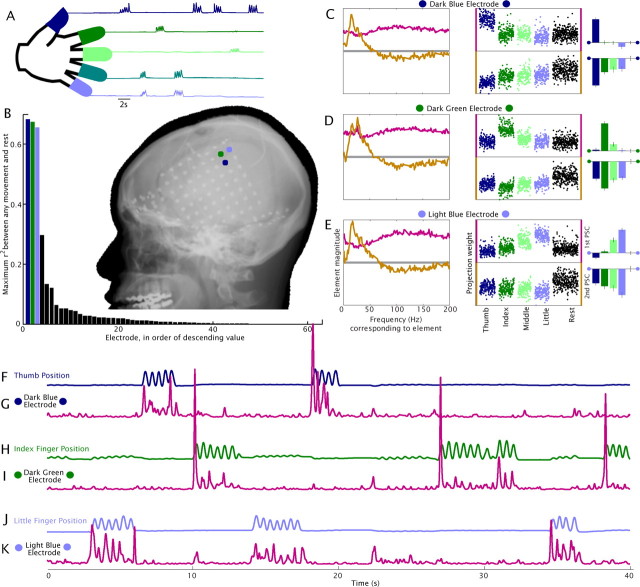Figure 2.
Capturing local cortical activity; individual digit representation in adjacent electrodes in subject 1. A, The position of each finger was measured using a transducing glove during cued flexion-extension. B, Axes, The maximum squared cross-correlation (r2) between sample projection weights to the first PSC, for each electrode, between any single movement type and rest, illustrates sparse digit representation (supplemental Figs. S4–6, available at www.jneurosci.org as supplemental material). Corresponding locations are shown in x-ray. Each of these shows specificity for a different type of finger movement, and the color code redundancy between the electrodes in B–K and digit movement type in A reflects this. C, Left, First (pink) and second (gold) PSCs generated from finger movements and rest, for the electrode shown in dark blue in the x-ray inset in B. Middle, As in Figure 1B. Right, Mean projection magnitudes for each finger type, with mean from rest samples subtracted. Error bars indicate ± 3 times the SE (3σ) of the mean (right most: rest samples). The upper bars represent the first PSC, and the lower are for the second. D, E, As in C, but for the dark green (D) and light blue (E) electrodes. F, H, J, Traces of thumb, index, and little finger position for a 40 s period. G, I, K, Projections of the time-frequency representation to the first PSC, “C1(t)”, for each of the three electrodes for same 40 s. Each electrode is specifically and strongly correlated with one movement type (r = 0.46 C1(t) from dark blue electrode-thumb; r = 0.47 green electrode-index finger; r = 0.29 light blue electrode-little finger; cross-combinations had a mean correlation of −0.09, indicating light hyperextension of other fingers while flexing the appropriate finger in this subject), over 10 min of continuous data (3.6 × 106 samples).

